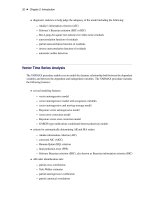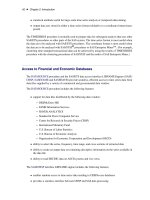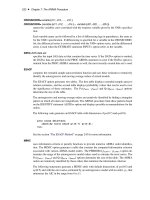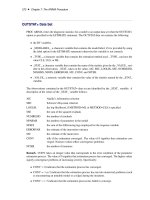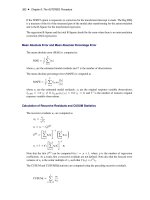SAS/ETS 9.22 User''''s Guide 234 pps
Bạn đang xem bản rút gọn của tài liệu. Xem và tải ngay bản đầy đủ của tài liệu tại đây (261.54 KB, 10 trang )
2322 ✦ Chapter 34: The X12 Procedure
PRINT=AUTOCHOICEMDL displays the table “Models Estimated by Automatic ARIMA
Model Selection Procedure.” This table summarizes the various models that were considered
by the TRAMO automatic model selection method and their measures of fit.
PRINT=BEST5MODEL displays the table “Best Five ARIMA Models Chosen by Automatic
Modeling.” This table ranks the five best models that were considered by the TRAMO
automatic modeling method.
BALANCED
specifies that the automatic modeling procedure prefer balanced models over unbalanced
models. A balanced model is one in which the sum of the AR, seasonal AR, differencing, and
seasonal differencing orders equals the sum of the MA and seasonal MA orders. Specifying
BALANCED gives the same preference as the TRAMO program. If BALANCED is not
specified, all models are given equal consideration.
HRINITIAL
specifies that Hannan-Rissanen estimation be done before exact maximum likelihood es-
timation to provide initial values. If HRINITIAL is specified, then models for which the
Hannan-Rissanen estimation has an unacceptable coefficient are rejected.
ACCEPTDEFAULT
specifies that the default model be chosen if its Ljung-Box Q is acceptable.
LJUNGBOXLIMIT=value
specifies acceptance criteria for confidence coefficient of the Ljung-Box Q statistic. If the
Ljung-Box Q for a final model is greater than this value, the model is rejected, the outlier
critical value is reduced, and outlier identification is redone with the reduced value. See the
REDUCECV option for more information. The value specified in the LJUNGBOXLIMIT=
option must be greater than 0 and less than 1. The default value is 0.95.
REDUCECV=value
specifies the percentage that the outlier critical value be reduced when a final model is found to
have an unacceptable confidence coefficient for the Ljung-Box Q statistic. This value should
be between 0 and 1. The default value is 0.14286.
ARMACV=value
specifies the threshold value for the t statistics that are associated with the highest-order
ARMA coefficients. As a check of model parsimony, the parameter estimates and t statistics
of the highest-order ARMA coefficients are examined to determine whether the coefficient
is insignificant. An ARMA coefficient is considered to be insignificant if the t value that is
displayed in the table “Exact ARMA Maximum Likelihood Estimation” is below the value
specified in the ARMACV= option and the absolute value of the parameter estimate is reliably
close to zero. The absolute value is considered to be reliably close to zero if it is below 0.15 for
150 or fewer observations or is below 0.1 for more than 150 observations. If the highest-order
ARMA coefficient is found to be insignificant, then the order of the ARMA model is reduced.
For example, if AUTOMDL identifies a (3 1 1)(0 0 1) model and the parameter estimate of
the seasonal MA lag of order 1 is –0.09 and its t value is –0.55, then the ARIMA model is
reduced to at least (3 1 1)(0 0 0). After the model is reestimated, the check for insignificant
coefficients is performed again. If ARMACV=0.54 is specified in the preceding example, then
the coefficient is not found to be insignificant and the model is not reduced.
OUTPUT Statement ✦ 2323
If a constant is allowed in the model and if the t value associated with the constant parameter
estimate is below the ARMACV= critical value, then the constant is considered to be insignif-
icant and is removed from the model. Note that if a constant is added to or removed from
the model and then the ARIMA model changes, then the t statistic for the constant parameter
estimate also changes. Thus, changing the ARMACV= value does not necessarily add or
remove a constant term from the model.
The value specified in the ARMACV= option should be greater than zero. The default value is
1.0.
OUTPUT Statement
OUTPUT OUT= SAS-data-set tablename1 tablename2 . . . ;
The OUTPUT statement creates an output data set that contains specified tables. The data set is
named by the OUT= option.
OUT=SAS-data-set
names the data set to contain the specified tables. If the OUT= option is omitted, the data set is
named using the default DATAn convention.
For each table to be included in the output data set, you must specify the X12 tablename
keyword. The keyword corresponds to the title label used by the Census Bureau X12-ARIMA
software. Currently available tables are A1, A2, A6, A7, A8, A8AO, A8LS, A8TC, A9, A10,
A19, B1, C17, C20, D1, D7, D8, D9, D10, D10B, D10D, D11, D11A, D11F, D11R, D12, D13,
D16, D16B, D18, E1, E2, E3, E5, E6, E6A, E6R, E7, E8, and MV1. If no table is specified in
the OUTPUT statement, Table A1 is output to the OUT= data set by default.
The tablename keywords that can be used in the OUTPUT statement are listed in the section
“Displayed Output/ODS Table Names/OUTPUT Tablename Keywords” on page 2342. The
following is an example of a VAR statement and an OUTPUT statement:
var sales costs;
output out=out_x12 b1 d11;
The default variable name used in the output data set is the input variable name followed by an
underscore and the corresponding table name. The variable sales_B1 contains the Table B1
values for the variable sales, the variable costs_B1 contains the Table B1 values for the variable
costs, while the Table D11 values for the variable sales are contained in the variable sales_D11,
and the variable costs_D11 contains the Table D11 values for the variable costs. If necessary,
the variable name is shortened so that the table name can be added. If the DATE= variable
is specified in the PROC X12 statement, then that variable is included in the output data set;
otherwise, a variable named _DATE_ is written to the OUT= data set as the date identifier.
2324 ✦ Chapter 34: The X12 Procedure
OUTLIER Statement
OUTLIER options ;
The OUTLIER statement specifies that the X12 procedure perform automatic detection of additive
point outliers, temporary change outliers, level shifts, or any combination of the three when using the
specified model. After outliers are identified, the appropriate regression variables are incorporated
into the model as “Automatically Identified Outliers,” and the model is reestimated. This procedure
is repeated until no additional outliers are found.
The OUTLIER statement also identifies potential outliers and lists them in the table “Potential
Outliers” in the displayed output. Potential outliers are identified by decreasing the critical value by
0.5.
In the output, the default initial critical values used for outlier detection in a given analysis are
displayed in the table “Critical Values to Use in Outlier Detection.” Outliers that are detected and
incorporated into the model are displayed in the output in the table “Regression Model Parameter
Estimates,” where the regression variable is listed as “Automatically Identified.”
The following options can appear in the OUTLIER statement:
SPAN=(mmmyy ,mmmyy )
SPAN=(’yyQq’ ,’yyQq’ )
gives the dates of the first and last observations to define a subset for searching for outliers. A
single date in parentheses is interpreted to be the starting date of the subset. To specify only
the ending date, use SPAN=(,mmmyy ) or SPAN=(,’yyQq’ ). If the starting or ending date is
omitted, then the first or last date, respectively, of the input data set or BY group is assumed.
Because the dates are input as strings and the quarterly dates begin with a numeric character,
the specification for a quarterly date must be enclosed in quotation marks. A four-digit year
can be specified. If a two-digit year is specified, the value specified in the YEARCUTOFF=
SAS system option applies.
TYPE=NONE
TYPE=(outlier types)
lists the outlier types to be detected by the automatic outlier identification method.
TYPE=NONE turns off outlier detection. The valid outlier types are AO, LS, and TC. The
default is TYPE=(AO LS).
CV=value
specifies an initial critical value to use for detection of all types of outliers. The absolute value
of the t statistic associated with an outlier parameter estimate is compared with the critical
value to determine the significance of the outlier. If the CV= option is not specified, then the
default initial critical value is computed using a formula presented by Ljung (1993), which
is based on the number of observations or model span used in the analysis. Table 34.2 gives
default critical values for various series lengths. Increasing the critical value decreases the
sensitivity of the outlier detection routine and can reduce the number of observations treated as
outliers. The automatic model identification process might lower the critical value by a certain
percentage, if the automatic model identification process fails to identify an acceptable model.
OUTLIER Statement ✦ 2325
Table 34.2 Default Critical Values for Outlier Identification
Number of Observations Outlier Critical Value
1 1.96
2 2.24
3 2.44
4 2.62
5 2.74
6 2.84
7 2.92
8 2.99
9 3.04
10 3.09
11 3.13
12 3.16
24 3.42
36 3.55
48 3.63
72 3.73
96 3.80
120 3.85
144 3.89
168 3.92
192 3.95
216 3.97
240 3.99
264 4.01
288 4.03
312 4.04
336 4.05
360 4.07
AOCV=value
specifies a critical value to use for additive point outliers. If AOCV is specified, this value
overrides any default critical value for AO outliers. See the CV= option for more details.
LSCV=value
specifies a critical value to use for level shift outliers. If LSCV is specified, this value overrides
any default critical value for LS outliers. See the CV= option for more details.
TCCV=value
specifies a critical value to use for temporary change outliers. If TCCV is specified, this value
overrides any default critical value for TC outliers. See the CV= option for more details.
2326 ✦ Chapter 34: The X12 Procedure
REGRESSION Statement
REGRESSION PREDEFINED= variables < / B=(value < F >) > ;
REGRESSION USERVAR= variables < / B=(value < F >) USERTYPE=option > ;
The REGRESSION statement includes regression variables in a regARIMA model or specifies
regression variables whose effects are to be removed by the IDENTIFY statement to aid in ARIMA
model identification. Predefined regression variables are selected with the PREDEFINED= option.
User-defined regression variables are specified with the USERVAR= option. The currently available
predefined variables are listed in Table 34.3. Table A6 in the displayed output generated by the
X12 procedure provides information related to trading day effects. Table A7 provides information
related to holiday effects. Tables A8, A8AO, A8LS, and A8TC provide information related to
outlier factors. Ramps and level shifts are combined in the A8LS table. The A8AO, A8LS and
A8TC tables are available only when more than one outlier type is present in the model. Table A9
provides information about user-defined regression effects. Table A10 provides information about
the user-defined seasonal component. Missing values in the span of an input series automatically
create missing value regressors. See the NOTRIMMISS option of the PROC X12 statement and
the section “Missing Values” on page 2339 for further details about missing values. Combining
your model with additional predefined regression variables can result in a singularity problem. If a
singularity occurs, then you might need to alter either the model or the choices of the predefined
regressors in order to successfully perform the regression.
In order to seasonally adjust a series that uses a regARIMA model, the factors derived from regression
are used as multiplicative or additive factors based on the mode of seasonal decomposition. Therefore,
regressors should be defined that are appropriate to the mode of the seasonal decomposition, so
that meaningful combined adjustment factors can be derived and adjustment diagnostics can be
generated. For example, if a regARIMA model is applied to a log-transformed series, then the
regression factors are expressed as ratios, which match the form of the seasonal factors that are
generated by the multiplicative or log-additive adjustment modes. Conversely, if a regARIMA model
is fit to the original series, then the regression factors are measured on the same scale as the original
series, which matches the scale of the seasonal factors that are generated by the additive adjustment
mode. Note that the default transformation (no transformation) and the default seasonal adjustment
mode (multiplicative) are in conflict. Thus when you specify the X11 statement and any of the
REGRESSION, INPUT, or EVENT statements, you must also specify either a transformation by
using the TRANSFORM statement or a different mode by using the MODE= option of the X11
statement in order to seasonally adjust the data that uses the regARIMA model.
According to Ladiray and Quenneville (2001), “X-12-ARIMA is based on the same principle [as
the X-11 method] but proposes, in addition, a complete module, called Reg-ARIMA, that allows
for the initial series to be corrected for all sorts of undesirable effects. These effects are estimated
using regression models with ARIMA errors (Findley et al. [23]).” The REGRESSION, INPUT, and
EVENT statements specify these regression effects. Predefined effects that can be corrected in this
manner are listed in the PREDEFINED= option. You can create your own definitions to remove
other effects by using the USERVAR= option and the EVENT statement.
Either the PREDEFINED= option or the USERVAR= option can be specified in a single REGRES-
SION statement, but not both. Multiple REGRESSION statements can be used.
REGRESSION Statement ✦ 2327
The following options can appear in the REGRESSION statement.
PREDEFINED=CONSTANT
PREDEFINED=EASTER(value)
PREDEFINED=LABOR(value)
PREDEFINED=LOM
PREDEFINED=LOMSTOCK
PREDEFINED=LOQ
PREDEFINED=LPYEAR
PREDEFINED=SCEASTER(value)
PREDEFINED=SEASONAL
PREDEFINED=SINCOS(value . . . )
PREDEFINED=TD
PREDEFINED=TD1COEF
PREDEFINED=TD1NOLPYEAR
PREDEFINED=TDNOLPYEAR
PREDEFINED=TDSTOCK(value)
PREDEFINED=THANK(value)
lists the predefined regression variables to be included in the model. Data values for these
variables are calculated by the program, mostly as functions of the calendar. Table 34.3 gives
definitions for the available predefined variables. The values LOM and LOQ are equivalent:
the actual regression is controlled by the PROC X12 SEASONS= option. Multiple predefined
regression variables can be used. The syntax for using both a length-of-month and a seasonal
regression can be in one of the following forms:
regression predefined=lom seasonal;
regression predefined=(lom seasonal);
regression predefined=lom predefined=seasonal;
Certain restrictions apply when you use more than one predefined regression variable. Only
one of TD, TDNOLPYEAR, TD1COEF, or TD1NOLPYEAR can be specified. LPYEAR
cannot be used with TD, TD1COEF, LOM, LOMSTOCK, or LOQ. LOM or LOQ cannot be
used with TD or TD1COEF.
The following restriction also applies to the SINCOS predefined regression variable. If
SINCOS is specified, then the INTERVAL= option or the SEASONS= option must also be
specified because there are restrictions to this regression variable based on the frequency of
the data.
2328 ✦ Chapter 34: The X12 Procedure
The predefined regression variables TDSTOCK, SCEASTER, EASTER, LABOR, THANK,
and SINCOS require extra parameters. Only one TDSTOCK regressor can be implemented in
the regression model. If multiple TDSTOCK variables are specified, PROC X12 uses the last
TDSTOCK variable specified. For SCEASTER, EASTER, LABOR, THANK, and SINCOS,
multiple regressors can be implemented in the model by specifying the variables with different
parameters. For example, the following statement specifies two EASTER regressors with
widths 7 and 14:
regression predefined=easter(7) easter(14);
For SINCOS, specifying a parameter includes both the sine and the cosine regressor except for
the highest order allowed (2 for quarterly data and 6 for monthly data.) The most common use
of the SINCOS variable for quarterly data is
regression predefined=sincos(1,2);
and for monthly data is
regression predefined=sincos(1,2,3,4,5,6);
These statements include 3 and 11 regressors in the model, respectively.
Table 34.3 Predefined Regression Variables in X-12-ARIMA
Regression Effect Variable Definitions
.1 B/
d
.1 B
s
/
D
I.t 1/;
Trend constant
CONSTANT
where I.t 1/ D
(
1 for t 1
0 for t < 1
E.w; t/ D
1
w
n
t
and
n
t
is the number of the w days before Easter that fall in month
Easter holiday (or quarter) t. (Note: This variable is 0 except in February, March,
EASTER(w) and April (or first and second quarter).
It is nonzero in February only for w > 22.)
Restriction: 1 Ä w Ä 25.
Labor Day L.w; t/ D
1
w
Œno. of the w days before Labor Day that fall in month t
LABOR(w) (Note: This variable is 0 except in August and September.)
Restriction: 1 Ä w Ä 25.
Length-of-month m
t
Nm where m
t
= length of month t (in days)
(monthly flow) and Nm D 30:4375 (average length of month)
LOM
REGRESSION Statement ✦ 2329
Table 34.3 continued
Regression Effect Variable Definitions
Stock length-of-month
LOMSTOCK
SLOM
t
D
(
m
t
Nm .l/ for t D 1
SLOM
t1
C m
t
Nm otherwise
where Nm and m
t
are defined in LOM and
.l/ D
8
ˆ
ˆ
ˆ
ˆ
<
ˆ
ˆ
ˆ
ˆ
:
0:375 when first February in series is a leap year
0:125 when second February in series is a leap year
0:125 when third February in series is a leap year
0:375 when fourth February in series is a leap year
Length-of-quarter q
t
Nq where q
t
= length of quarter t (in days)
(quarterly flow) and Nq D 91:3125 (average length of quarter)
LOQ
Leap year
(monthly and quarterly flow)
LPYEAR
LY
t
D
8
ˆ
<
ˆ
:
0:75 in leap year February (first quarter)
0:25 in other Februaries (first quarter)
0 otherwise
Statistics Canada Easter If Easter falls before April w, let n
E
be the number of the w days
(monthly or quarterly flow) on or before Easter that fall in March. Then:
SCEASTER(w)
E.w; t/ D
8
ˆ
<
ˆ
:
n
E
=w in March
n
E
=w in April
0 otherwise
If Easter falls on or after April w, then E.w; t/ D 0.
(Note: This variable is 0 except in March and April (or first and
second quarter).) Restriction: 1 Ä w Ä 24.
Fixed seasonal
SEASONAL
M
1;t
D
8
ˆ
<
ˆ
:
1 in January
1 in December
0 otherwise
; : : : ; M
11;t
D
8
ˆ
<
ˆ
:
1 in November
1 in December
0 otherwise
Fixed seasonal si n.w
j
t/; cos.w
j
t/;
SINCOS(j ) where w
j
D 2j=s; 1 Ä j Ä s=2 and s is the seasonal period
SINCOS(j
1
; : : : ; j
n
) (drop si n.w
j
t/ Á 0 for j D s=2)
Restrictions: 1 Ä j
i
Ä s=2, 1 Ä n Ä s=2.
2330 ✦ Chapter 34: The X12 Procedure
Table 34.3 continued
Regression Effect Variable Definitions
Trading day T
1;t
D (number of Mondays) – (number of Sundays)
TD, TDNOLPYEAR ; : : : ; T
6;t
D (number of Saturdays) – (number of Sundays)
One coefficient trading day (number of weekdays)
5
2
(number of Saturdays and Sundays)
TD1COEF, TD1NOLPYEAR
Stock trading day
TDSTOCK(w)
D
1;t
D
8
ˆ
<
ˆ
:
1 Qw
th
day of month t is a Monday
1 Qw
th
day of month t is a Sunday
0 otherwise
; : : : ; D
6;t
D
8
ˆ
<
ˆ
:
1 Qw
th
day of month t is a Saturday
1 Qw
th
day of month t is a Sunday
0 otherwise
where Qw is the smaller of w and the length of month t.
For end-of-month stock series, set w to 31; that is,
specify TDSTOCK(31). Restriction: 1 Ä w Ä 31.
Thanksgiving T hC.w; t/ D proportion of days from w days before Thanksgiving
THANK(w) through December 24 that fall in month t (negative values of w indicate
days after Thanksgiving).
(Note: This variable is 0 except in November and December.)
Restriction: 8 Ä w Ä 17.
USERVAR=(variables)
specifies variables in the PROC X12 DATA= or AUXDATA= data set that are to be used
as regressors. The variables in the data set should contain the values for each observation
that define the regressor. Regression variables should also include future values in the data
set for the forecast horizon if the time series is to be extended with regARIMA forecasts.
Missing values are not permitted within the data span, including forecasts, of the user-defined
regressors. Example 34.6 shows how to create an input data set that contains both the series to
be seasonally adjusted and a user-defined input variable. Note that all regression variables in the
USERVAR= option apply to all time series to be seasonally adjusted unless the MDLINFOIN=
data set specifies different regression information.
B=(value <F> . . . )
specifies initial or fixed values for the regression parameters in the order in which they appear
in the PREDEFINED= and USERVAR= options. Each B= list applies to the PREDEFINED=
or USERVAR= variable list that immediately precedes the slash. The PREDEFINED= option
and the USERVAR= option cannot be specified in the same REGRESSION statement; however,
multiple REGRESSION statements can be specified.
REGRESSION Statement ✦ 2331
For example, the following statements set an initial value for the user-defined regressor, x, of 1:
regression predefined=LOM ;
regression uservar=x / b=1 2 ;
In this example, the B= option applies only to the USERVAR= statement. The value 2 is
discarded since there is only one variable in the USERVAR= list. To assign an initial value of
1 to the LOM regressor and 2 to the x regressor, use the following statements:
regression predefined=LOM / b=1;
regression uservar=x / b=2 ;
An F immediately following the numerical value indicates that this is not an initial value, but
a fixed value. See Example 34.8 for an example that uses fixed parameters. In PROC X12,
individual parameters can be fixed while other parameters in the same model are estimated.
USERTYPE=AO
USERTYPE=CONSTANT
USERTYPE=EASTER
USERTYPE=HOLIDAY
USERTYPE=LABOR
USERTYPE=LOM
USERTYPE=LOMSTOCK
USERTYPE=LOQ
USERTYPE=LPYEAR
USERTYPE=LS
USERTYPE=RP
USERTYPE=SCEASTER
USERTYPE=SEASONAL
USERTYPE=TC
USERTYPE=TD
USERTYPE=TDSTOCK
USERTYPE=THANKS
USERTYPE=USER
enables a user-defined variable to be processed in the same manner as a U.S. Census predefined
variable. For instance, the U.S. Census Bureau EASTER(
w
) regression effects are included
the “RegARIMA Holiday Component” table (A7). You should specify USERTYPE=EASTER
to include a user-defined variable which would be processed exactly as the U.S. Census
predefined EASTER(
w
) variable, including inclusion in the A7 table. Each USERTYPE= list
applies to the USERVAR= variable list that immediately precedes the slash. USERTYPE=
does not apply to U.S. Census predefined variables. The same rules for assigning B= values to
regression variables apply for USERTYPE= options. See the example in B=(value <F> . . . ).
